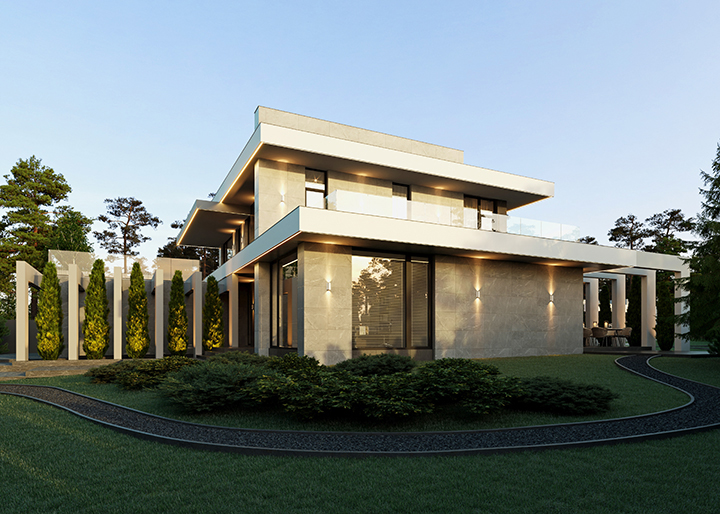Revolutionizing Real Estate Financing for Communities

The Rise of Modular Bridge Financing
By Amy Martinson
In today’s changing real estate market, challenges drive innovation. As housing costs rise, inventory shrinks, and affordability becomes a distant goal for many, a transformation is underway. This shift offers a practical response to our current issues. In the realm of modular housing, a new solution is emerging with the potential to change how we view real estate and its financing.
Navigating a Complex Real Estate Landscape
The post-pandemic world has created a complex landscape for developers, investors, real estate agents, brokers, and loan originators for three main reasons:
» Inflated Money and Higher Interest Rates // Affordability takes a hit as money inflates and interest rates rise.
» Shortage of Available Inventory // Intensified scarcity and competition in the housing market combined with the inability for existing homeowners to move up into new homes.
» Reduced Refinancing Incentive // Since interest rates are currently in the 7%+ range on long-term fixed debt and 9%+ on home equity lines of credit, property turnover is slowing.
In August, the California Association of Realtors (CAR) reported that the median home price in California reached $859,800, a 3.3% increase from July and a 3.0% rise from the same month in 2022. However, the housing market faced challenges, including rising mortgage rates and a shortage of available homes. Despite these challenges, there was continued strong interest from potential buyers.
Amidst the housing crisis, the real estate market experienced a notable phenomenon known as the ‘refinance boom’ in the years 2020-2021. This boom was driven by historically low interest rates, strong household balance sheets, and increased demand for housing. Homeowners who participated in this refinance boom either lowered their monthly mortgage payments or extracted equity from their real estate assets. Approximately one-third of outstanding mortgage balances were refinanced during this period, resulting in improved cash flow for many homeowners.
However, this refinance trend started to wane as mortgage rates increased sharply by 400 basis points from their historic lows. The impact of this refinance boom is expected to have long-term effects on the mortgage market, improving the financial position of homeowners and providing potential support for future consumption.
Addressing the Housing Crisis: Rise of Modular Housing
A housing crisis that is marked by inflation, rising rates, inventory shortages, and reduced refinancing incentives, presents a unique opportunity. These challenges have sparked discussions on innovative approaches to make housing more affordable and accessible, and modular housing has emerged as a promising solution.
Unlike traditional construction methods, modular housing involves building homes in controlled factory environments. This offers numerous advantages that set it apart from traditional construction methods. These include significant cost and time savings, facilitated by the controlled factory environment where homes are constructed. Furthermore, the streamlined modular approach simplifies permitting by shifting inspections from the city level to the state level, reducing bureaucratic hurdles. Additionally, modular housing minimizes the reliance on skilled labor, making the construction process more accessible. Lastly, it boasts a reduced environmental impact, aligning with sustainability goals by optimizing resource use and minimizing waste.
The Growing Modular Housing Market
According to industry projections, the market for modular-built homes is set to surge from its current $32.49 billion in 2023 to $40.70 billion by 2028, with a Compound Annual Growth Rate (CAGR) of 4.61%. This presents a favorable money-making opportunity for smart brokers, agents, and investors.
There are five distinct target markets who can benefit from this growth:
» Homeowners aiming to increase their property values and supplement their income.
» Developers looking to lower production costs and shorten construction timelines to enhance profitability in their projects.
» Investors interested in capitalizing on the growing demand for luxury modular homes and the potential for returns.
» Property Owners of land who want to build anew, bypassing traditional construction challenges and costs.
» Potential New Home Buyers who thought they could not afford a new home but are attracted to the affordability and benefits of modular construction.
Bridging the Financing Gap for Modular Homes
The enticing potential of modular housing is also creating financing opportunities that need to be explored for mass adoption. One of the key obstacles is the gap between production and placement. Modular homes are produced in factories but require bridge financing until they are permanently placed on a foundation. This transitional phase can lead to complexities in securing suitable financing options. Traditional mortgage financing models are often too inflexible in a world where technology and innovation are driving modular-building techniques.
Challenges and Opportunities Ahead
The journey toward mainstream acceptance for modular housing is not without its hurdles. Communication gaps among stakeholders, including manufacturers, builders, regulators, and government entities, can lead to confusion and slow down the adoption process. You may think navigating regulatory frameworks can be cumbersome and unpredictable, impacting the scalability of modular housing initiatives. However, for those who utilize proven processes and systems for proper due diligence, modular-built communities become easier to produce and more profitable.
Potential Financial Gains through Innovative Solutions
There is a silver lining in the form of potential financial gains. Modular housing’s adoption can yield substantial rewards for both the industry and local communities. By streamlining communication, advocating for favorable regulations, and fostering collaboration among stakeholders, the groundwork can be laid for factory-built solutions to address the housing crisis head-on.
In conclusion, housing is a multifaceted issue that demands creative solutions. Modular housing’s capacity to reduce construction time and costs presents a compelling argument for its integration into the broader housing conversation. Replacing aged housing stock, increasing profitability for stakeholders and minimizing environmental solutions are just a few of the significant opportunities at the forefront of this industry now.
Learn more about financing modular housing at https://www.modufi.net/














